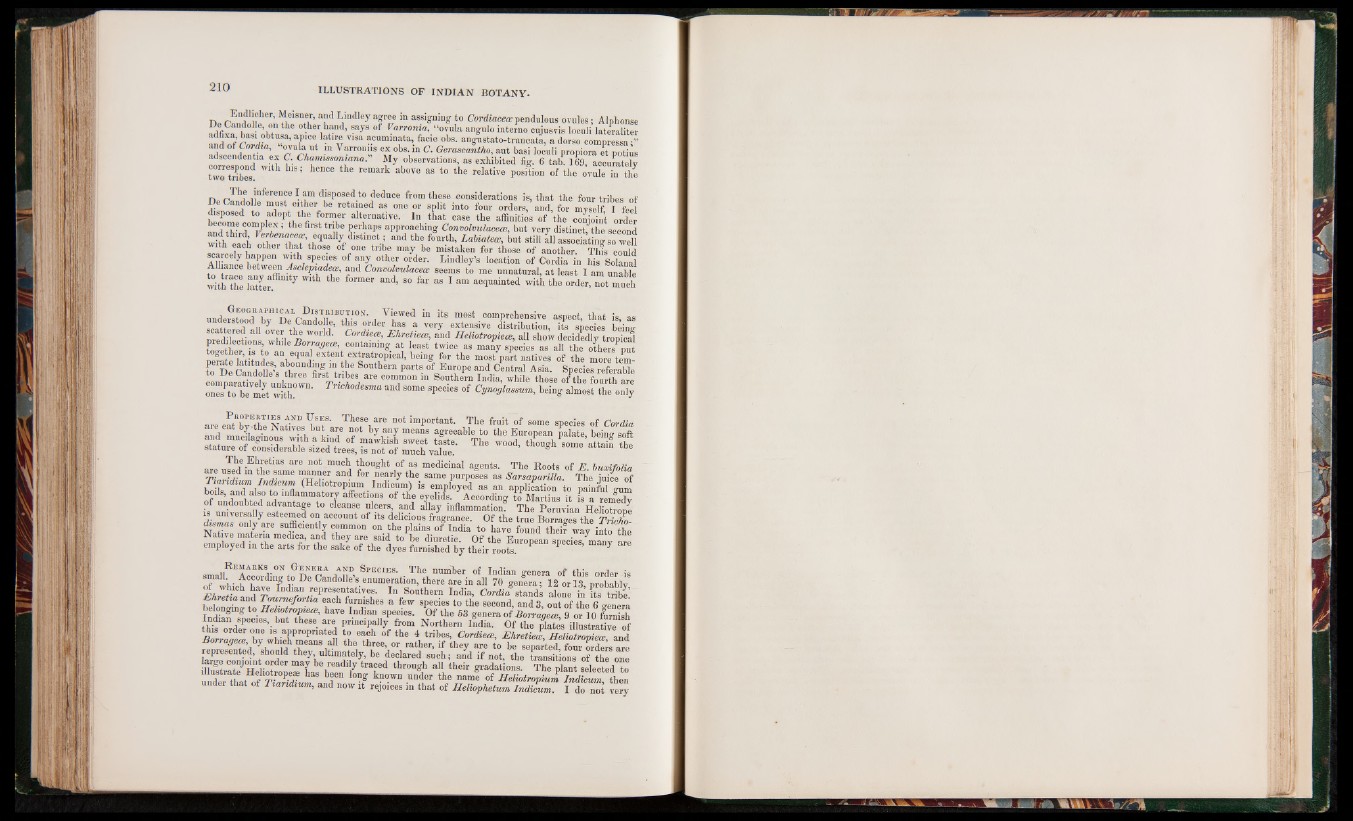
n „ f w ? , , ’ ^ ,818n“ > a"d I ;m<31ey I assigning to Cordiacece pendulons ovules; Alphonse
S f i S t r ’lT 0‘her1hand> 6ays of yarronia, “ovula angulo interne cujusvis W
^, ,obt“fa’ 3Plce latlre V13a acuminata, facie obs. angustato-trnncata, a dorso compressa;”
and Of Cordra, “ovula ut m Varron.is ex obs. in C. Gerascantho, ant basi loculi propiora e^ potius
adscendentia ex C. Chamissomana." My observations, as exhibited fig. 6 tabP 169, accurately
tTotoibe" 5 6 remark ab°Ve 38 t0 the relative ihe o v l i n Z
Do r T*!te ,!nfereIT dislJosed to deduce from these considerations is, that the four tribes of
De Candolle must either be retained as one or split into four orders, and, for myself I feel
disposed to adopt the former alternative. In that case the affinities of the conjoint order
and tV d ° T ;,X: the firSt tr',l,e PerhaI,s approaching Convolvulacece, but very distinct,Jthe second
and third Verbenaaeaf, equally distinct; and the fourth, Labiate*, but still all associating so well Z^LTl! °ther thfn‘ Ul0Se 111 tribe may ba mistaken for those of IHlMHBg scarcely happen with species of any other order. Lindley’s location of Cordia in his Solanal
to tra°e betW6ffi AscleV™de^ and Convolvulacece seems to me unnatural, at least I am unable
with the n m h “e f0rmer an<J’ S° ^ 38 1 am acquainted with the order, not much
L t I Viewed in its most comprehensive aspect, that is, as
t . epSHI De Candolle, this order has a very extensive distribution, its species being
scattered all over the world. Cor diem, Ehretiece, and HeUotropiece, all show decidedly trODicai
predilections wh.le Barrage*, containing at least twice as M l W i iM
together, is to an equal extent extratropical, being for the most part natives of the more torn
to De abound‘ng m the Southern parts of Europe and Central Asia. Species referable
to De Candolles three first tribes are common in Southern India, while those of the fourth are
Trichode™* and some species of Cynoglassum, being almost the only
„ I I M I B f ND YSES' Tbese are not imPortant. The fruit of some species of Cordia
and m.md'tbe Natly?s bu‘ ° ot by any means agreeable to the European palate, being soft
and mucilaginous with a kind of mawkish sweet taste. The wood, though some attafa the
stature of considerable sized trees, is not of much value. 8
TheEhretias are not much thought of as medicinal agents. The Roots of E bumfolia
x L r i d t Z 6 .®ame “ rt and for nearly the same purposes as Sarsaparilla. The ,jui£ ^of
Tiaridium Indicum (Hehotropium Indicum) is employed as an application to painful cram
of‘undoubted0 I f mflammatory affeotl°DS of the eyelids. According to Martins it fs a remedy
of undoubted advantage to cleanse ulcers, and allay inflammation! The Peruvian Heliotrooe
is universally esteemed on account of its delicious fragrance. Of the true Borrages the Tricho-
Natlve “ i7 316 S“,®Cient J ??mmon 00 the PIail>8 of India to have found their way into the
Native materia medica, and they are said to be diuretic. Of the European species manv are
employed in the arts for the sake of the dyes furnished by their roots. ’ ^
am»llREAAaKd-°N*G?iNEn A M M SrECIES- The number of Indian genera of this order-is
small According to De Candolle s enumeration, there are in all 70 genera; 12 or 13 probably
”b " ‘! cb baI e Indian representatives. In Southern India, — 1 a C e in its S ’
Ehretia and Tourneforha each furnishes a few species to the second, and 3, out of the 6 genera
belonging to Helmtroptem, have Indian species. Of the 53 genera of Borrage*, 9 or 10 famish
Indian species, but these are principally from Northern India. Of the plates illustrative of
this order one is appropriated to each of the 4 tribes, Cardie*, E h r e l l m H e l ^ ^ l n A
Barrage* by which means all the three, or rather, if they are to be seZrted W o d ^ s are
represented, should they ultimately, be declared such; and if not, the Lnsitions of the one
lIu s to a trC io tro p e rL s ebeeeadl y thr°US?1 a11. their gradations.illustrate Meliotropese has been long known under the name of Helio troTmhuem p laInndt isceulemc tedth etno
under that of Tiandium,, and now it rejoices in that of Heliophetum Indicum. I do not very